UGC will be the Queen (or King) of social in 2024

In the sparkling world of social media, one trend is set to dominate in 2024 - user-generated conte…
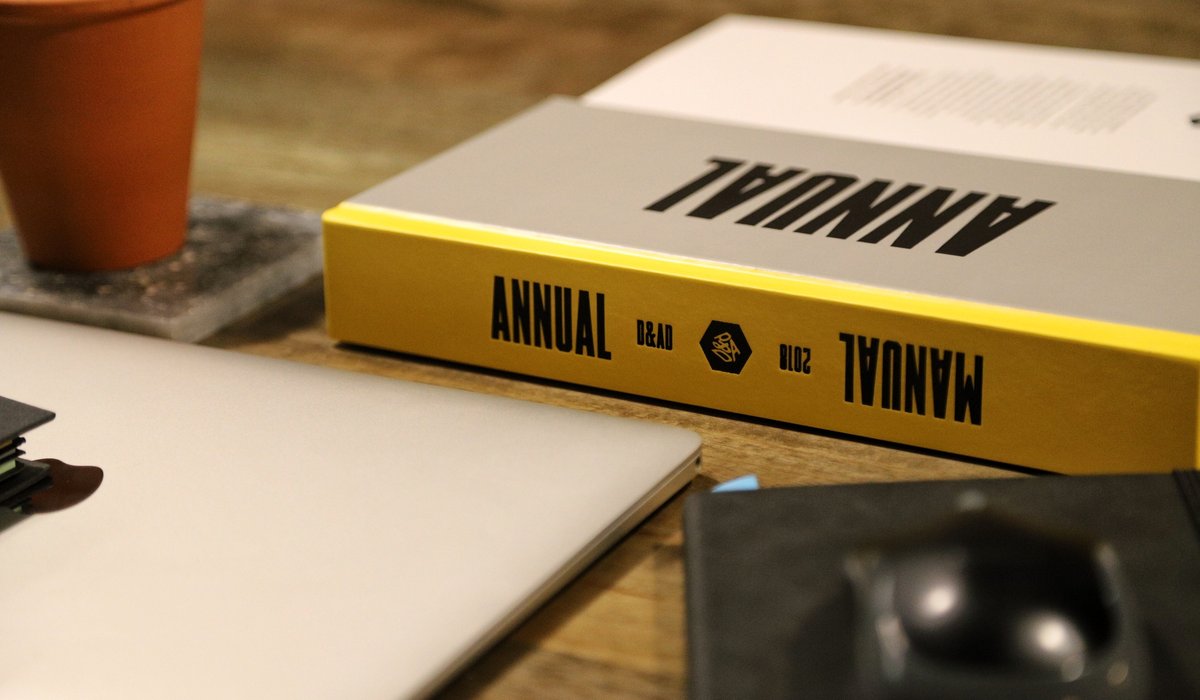
Influencer marketing can be a great way of shifting perceptions and consumer behaviour around your brand, products and services. But it needs to be done strategically to be successful.
We’ve all seen stories of when it’s gone wrong. The reason is usually inadequate planning, which results in inauthentic content. However, for many brands it works incredibly well and helps them to reach and resonate with new audiences.
Here, we'll talk you through how to structure your influencer campaigns.
In the loosest sense, influencer marketing is simply a form of collaboration. A business working with an influential person to promote something. It could be a product, service or campaign.
You might associate it with Instagrammers, vloggers and TikTok sensations. But you should consider partnering with other content creators, bloggers and opinion leaders.
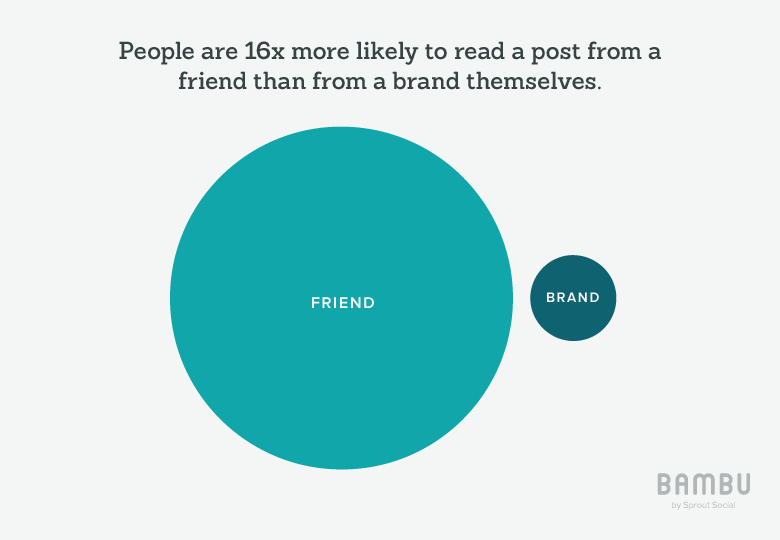
There are a few key reasons why influencer marketing is a good idea:
1 - Social proof.
This is one of the core principles of behavioural psychology. Influencer marketing works because of the trust and authority they have with followers. Endorsements and reviews can social proof your brand to potential customers.
2 - Borrowed authority.
Working with influencers allows your brand to extend its natural areas of authority. You can build on core competencies and effectively borrow some of their authority or expertise to lend support to your marketing activities.
3 - Reach x resonance.
You can achieve much greater reach and engagement by collaborating with influencers. It helps to propel your message beyond brand channels, which also outsmarts the Facebook algorithm that downgrades content from company pages.
Working with influencers should be part of an integrated strategy. A good way to visualise this in the form of a Venn diagram. You should see your influencer campaigns as an extension of your content and engagement strategies. Amplifying your brand and reaching new audiences.
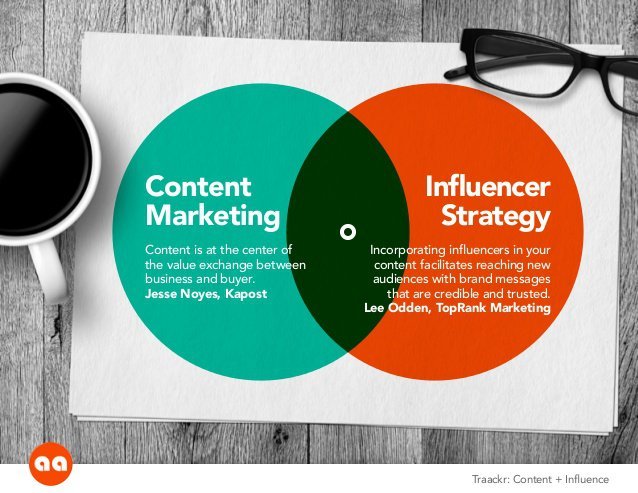
Here are a few pointers to get you started with this:
1 - Know your audience
If you’ve built personas, you’ll understand your target market demographically as well as the psychographic factors that affect behaviour. This means you can select influencers that have followers with similar attributes and interests.
2 - Co-create / collaborate
The key is to think of influencers as co-creators, not just as promoters of your brand. The relationship needs to be mutually beneficial and built on collaboration. The content must be relevant and authentic for it to have influence.
3 - Marketing channels
You know where your customers spend their time online and which channels to prioritise to reach them. If you already have a strong presence on Twitter, maybe work with vloggers and repurpose video content for other channels.
As with any marketing campaign, start by identifying goals. Set your intentions and be clear about what you’d like to accomplish. This will help to prioritise metrics and measure the success of your influencer campaign (see later section).
Many people skip this and try to run influencer campaigns without a strategy. This makes it more of a gamble than a tactical investment and exposes it to reasonable questions of ROI.
With that in mind, here are a few tips:
1 - Objectives x key results (OKRs)
Select a primary objective e.g. brand awareness. Then set a quantifiable goal e.g. 100k impressions. This can be graded to give a score. So if the outcome was 90k, that’d be 9/10.
2 - Focus on SMART goals.
Your goals should always be specific, measurable, attainable, relevant and time-bound (aka the SMART method). This will allow you to set realistic goals and show the ROI.
3 - Awareness vs Direct Response
At the highest level, your KPIs can be divided between these two types. Or you might want a combination. Track awareness and engagement as well as the knock-on effect on sales.
On this last point, keep in mind that social media works best as an awareness channel rather than for driving direct conversions. However, it’s a good idea to track the latter too.
For local chocolatier Cocoa Amore, we ran an influencer campaign that measured both. Our primary objectives were reach and engagement. But we also gave each influencer a unique discount code to share with their followers and tracked referral traffic and conversions.
The key is to document your KPIs. You can then measure against these and loop the insights from each campaign into the next, developing your influencer strategy as you go.
You’ll need to size up your budget alongside your campaign objectives. It’s great to be ambitious, but your goals need to be attainable. So be realistic about how much you have to spend and scale up your activity once you’ve achieved some success.
Budget will partially determine the influencer tiers you’ll be working in. With a large budget, you’ll be able to partner with mega- and macro-influencers, whereas smaller budgets may limit you to micro- and nano-influencers.
Here’s a loose categorisation of influencer tiers:
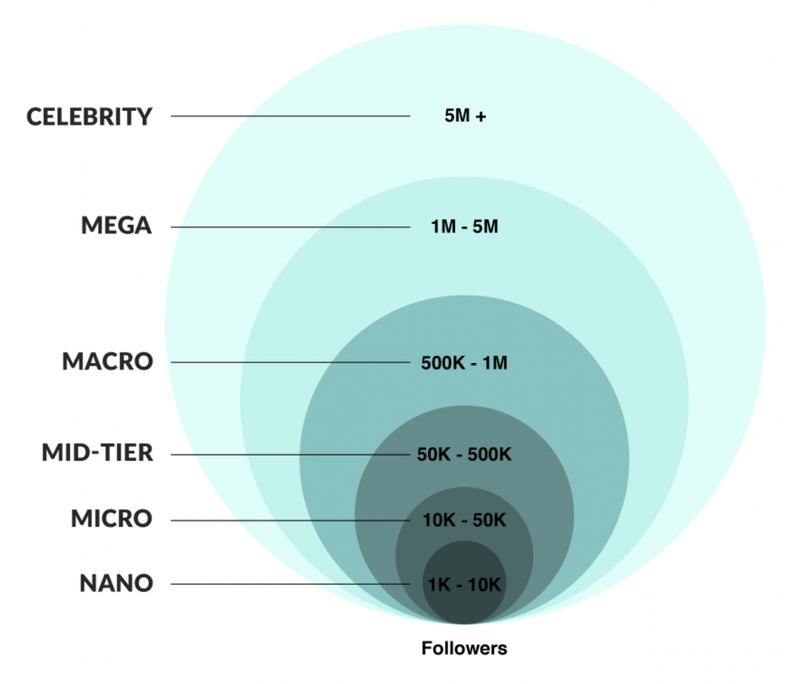
Source: Mediakix
But that’s not the full story because followers aren’t always an accurate gauge of ROI. As a general rule, there’s an inverse relationship between follower count and average engagement rate. Put simply, nano- and micro-influencers will drive higher relative engagement. They’ll reach less people, but arguably their content will have more influence on the social media users that see it. Payment rates vary across tiers and industries. Gifting is popular with nano- and micro-influencers, which could be great if you’re launching a new product and want to generate a buzz around it. Other factors that affect influencer pricing include usage rights, exclusivity and more. It might be best to collaborate with 10 micro-influencers rather than one macro-influencer, but don’t underestimate the time (and therefore cost) it’ll take to foster these relationships.
Finding the right influencers to partner with might feel like a daunting task, especially if you’re doing it for the first time. But if you know your audience and their interests, that’s a great starting point.
You’ll also know which social platforms to prioritise and that’ll help to steer your research. Remember that most influencers will usually lean more heavily on one, but will have a presence across channels.
For example, many Instagram influencers are active on YouTube and/or will have their own blog. So be targeted with your research, but be alive to the potential of cross-channel influence too.
A few pointers to help with your research:
1 - Start with mentions and hashtags
Ideally you want influencers with natural affinity for your brand. Happy customers make the best advocates. Start by going through mentions, hashtags and post engagements. You may find what you’re looking for in existing fans/followers and can develop those relationships.
2 - Use influencer marketing tools
Tools like BuzzSumo and Social Blade are great for researching influencers. Followerwonk lets you search Twitter bios and BuzzStream is another that often gets touted. We’ve used all of these on a piecemeal basis, but tend to rely on HypeAuditor for it’s all-round service.
HypeAuditor lets you search by demographics and influencer categories. Crucially, you can filter the results by quality score, engagement rate and brand mentions as well as audience size. Here’s a quick snapshot of the discovery interface:
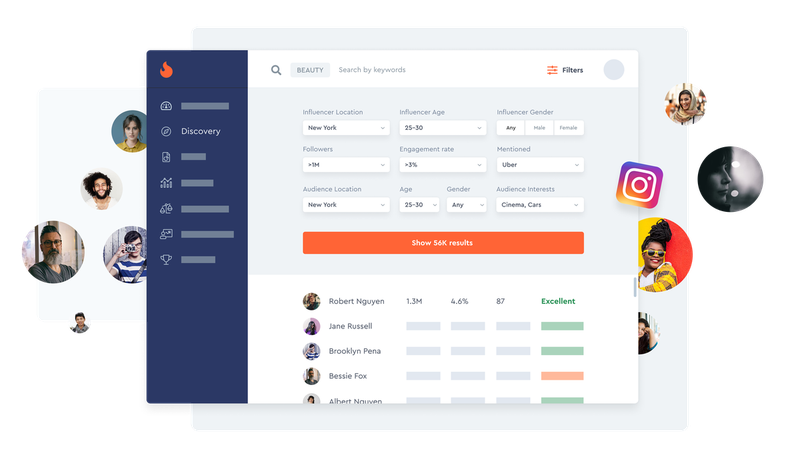
Source: HypeAuditorDiscovery
3 - Look at referral traffic and blogs
Another method is looking into backlinks. Understandably, social media is the main way of finding influencers, but referral traffic allows you to identify blogs and forums. We also use the brand mentions and topic research features within SEMrush to broaden our search.
Okay so that’ll help with your research, but where to store the information? The perceived value of each influencer is relative to the next and you need to be able to compare them.
The way we do it is by creating a list using Google Sheets. We loosely group the influencers by follower count and average engagement rate (ER). Using conditional formatting to colour-code them.
Here is blank example to show what we mean:
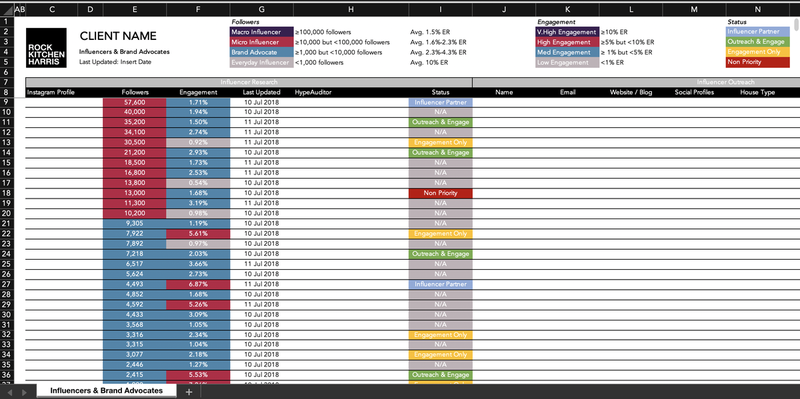
By doing this, we’re able to separate the macro- from micro-influencers. We also note the average ER for each of these tiers. For example, 1.5% ER would be fairly typical of the former, whereas this would be considered low for a nano- or micro-influencer.
This is the first step in qualifying influencers, but by no means the last. It’s helpful to view ER in the context of audience size. As we go through the process we continue to gather more data and narrow down which influencers to work with.
At this stage, it’s not a binary in/out choice. We’re creating a long list of potential influencers and turning this into a shortlist based on a combination of data-led insight and manual outreach.
When developing your influencer strategy, you should look to strike a balance between relevance, reach and resonance. It can be easy to get lost in the nitty-gritty, but these are the bigger picture things that success will hinge on.
Here’s a quick breakdown of each of them:
1 - Relevance
Influencers need to have an audience that aligns with your target market. Followers need to be demographically similar and have similar likes or interests. Without this, the content won’t be memorable or impactful.
2 - Reach
By partnering with influencers, you’ll be extending the reach of your brand. So you need to factor in how many impressions the content will create and people it will reach. Creating awareness of your product, service or campaign.
3 - Resonance
It’s important that influencer content connects with the audience and drives meaningful engagement for your brand. This could be in the form of metrics such as likes, comments and share as well as clicks and goal completions.
The interplay between the three Rs is important. For a challenger brand, it might be tempting to partner with nano- or micro-influencers, which often have higher engagement. But brand awareness is important for a challenger and this might not provide the same reach as established brands.
So it’s about compromise, but also about finding the right balance for your brand.
When an influencer looks promising, we’ll add them to the list and might start with some initial light engagement. Liking and commenting on their posts. Small acts, just to see how they respond.
If we think they might be a good fit, we’ll then run a report to audit their profiles. As such, audience size and engagement only act as pre-qualification to build on with more data and analytics.
We tend to use HypeAudit and use this to uncover:
1 - Audience type and quality
We can drill down into demographics such as location, age and gender. It divides their audience into four groups: real people, influencers, mass followers and suspicious accounts. An audience quality score (AQS) also helps to benchmark the influencer.
Source: HypeAuditor Reports
2 - In-depth engagement analysis
The average engagement rate (ER) is a useful feature, especially when compared to the industry benchmark. HypeAuditor also charts engagement over time, checks for authenticity and can even detect so-called engagement pods on Instagram.
3 - Follower growth trends
You’ll get historical data on audience growth, which is invaluable when looking to see if the pattern looks genuine or not. Aided by machine learning, the tool will flag any suspicious trends and whether an influencer uses the follow/unfollow trick.
Okay, but is all this analysis necessary? That’s probably what you’re thinking.
We’ve run influencer campaigns for a variety of clients and sadly these vetting techniques are still needed. Not all influencers are genuine, and nor is their perceived influence. Here’s an example.
One influencer had a high AQS and smooth audience growth:

Another had a low AQS and a sharp jump in new followers:

Source: HypeAuditorReports
On the surface, the second seemed a good fit for the brand. But on closer inspection, the followers seem to have been artificially acquired and that’s also reflected in the poor AQS.
If your budget won’t stretch to HypeAuditor, other tools are available. For example, Upfluence has a Chrome extension that allows you to pull analytics at the click of a button.
But if you’re serious about generating ROI from your influencer marketing, our advice would be to invest in these analytics tools and carefully select who you choose to represent your brand.
For nano- and micro-influencers you can usually strike up conversation via direct message. Others might prefer email. It can also be useful to have a video call to get a feel for what they’re like as a person and to discuss potential ideas.
You may have to go through a management firm or agent for more seasoned influencers. Either way, the key is to make it personal and show that you’re serious about a potential partnership.
Influencers want to know that the brands they work with are legitimate and well-intentioned. They’ve built an engaged following, so it’s within their interests to ensure that any collaboration or promoted content will appeal to their audience too.
Talk about your campaign and how it might fit with their profile and audience. But also ask about their goals and what they’re hoping to achieve. Ultimately you’re looking to see if there’s a good fit between the influencer and your brand, so make it conversational and get to know them.
When you’re satisfied with your choice, invite the influencer to collaborate with your brand. The key is explore ideas and find something that’s mutually beneficial.
It’s not an exact science, but here are a few pointers:
1 - Explore opportunities
The content needs to do two things: be authentic to the influencer, but also relevant and impactful for your brand. So be open to ideas and develop them in close partnership.
2 - Content x messaging
Create a brief to communicate your brand goals and messaging. Agree on content, timelines and the channels it’ll be promoted on. Plus any hashtags and CTAs to be used.
3 - Encourage creativity
Be willing to give up some creative control. The content the influencer creates will need to be consistent with their personal brand in order to come across as genuine and authentic.
4 - Set clear expectations
Create an influencer agreement, especially when partnering with macro influencers. Be clear about ownership, exclusivity and advertising guidelines as well as payment terms.
5 - Develop a relationship
Invest in long-term partnerships rather than one-time campaigns. Work with influencers that consistently deliver value and potentially turn them into ambassadors for your brand.
There are various ways to track performance and what you measure will largely be determined by the objectives you set at the beginning of the campaign. So look for metrics that align with these.
Refer back to the SMART goals you set and use these to gauge the success of the campaign. As a rule of thumb, here are some of the key areas you’ll want to include when assessing ROI.
1 - Social media metrics
Track awareness metrics like reach and impressions. Measure overall engagement as well as granular metrics such as likes, comments and shares. Instagram saves are an indication that users may want to revisit the content later. Views are also important for video content.
2 - Consider the three Rs
Show how the influencer content resonated with the audience by tracking their actions. This might be clicks and swipe-ups on Instagram stories, but also goal completions on your site. Use hashtags and social listening tools to track mentions, which shows wider resonance.
Where possible, connect your influencer marketing with the customer journey. Be clear that social is predominantly an awareness channel, but track metrics across the other stages.

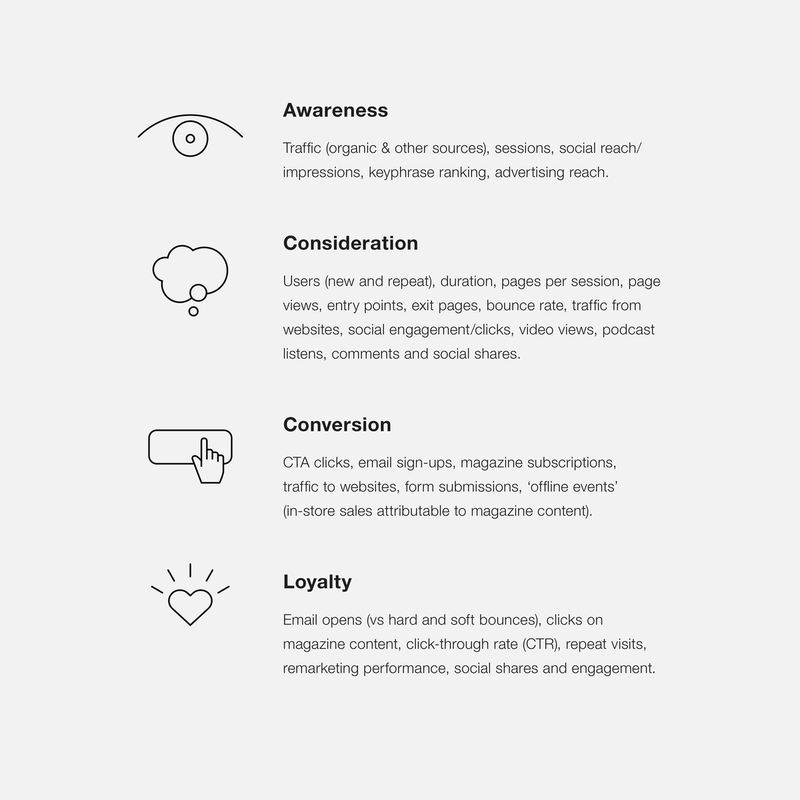
3 - Website metrics
Extract any relevant data from Google Analytics such as site visits, referral traffic (from social and bloggers) and page views. For big campaigns, it might be beneficial to create custom landing pages for each influencer. Also look for audience insights and any shifts in behaviour.
For example, when we analysed the Cocoa Amore influencer campaign we found that social referrals were up, but also most were new users and the audience we’d sought to engage.
4 - UTM tracking
By using the Campaign URL Builder by Google, you’ll be able to create custom links for each influencer. This will mean that you’ll be able to look in-depth and aggregate the data from your influencer campaign. This can then be pulled into a centralised reporting dashboard.
NB. We use Google Data Studio for most of our reporting. Combining influencer metrics with your other marketing metrics is the best way to integrate it and show the results.

5 - Instagram paid partnership
You’ll be relying on influencers to provide you with the necessary data to complete your reports. However, you could use Instagram’s paid partnership feature, which could save you some time later. Once setup, it’ll pull in the data for you via Facebook Business Manager.
Lastly, it’s important to follow the rules around influencer marketing. That means being transparent and using the hashtag #ad on promoted content.
We’re a member of the Institute of Practitioners in Advertising (IPA) and take guidance from their team when it comes to running influencer campaigns. Some people assume the rules only apply to paid partnerships, but it still applies any exchange of value including free products and gifts.
So just make sure that you keep up with the changing landscape for influencer marketing and adjust your strategy accordingly.
__
Get in touch with us if you’d like to discuss how we can help with your influencer strategy.